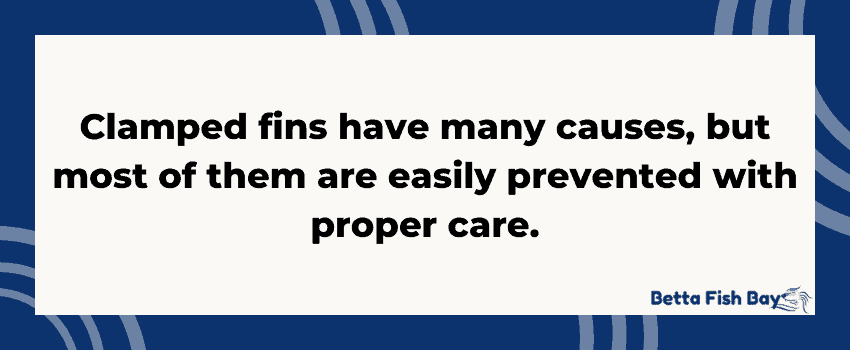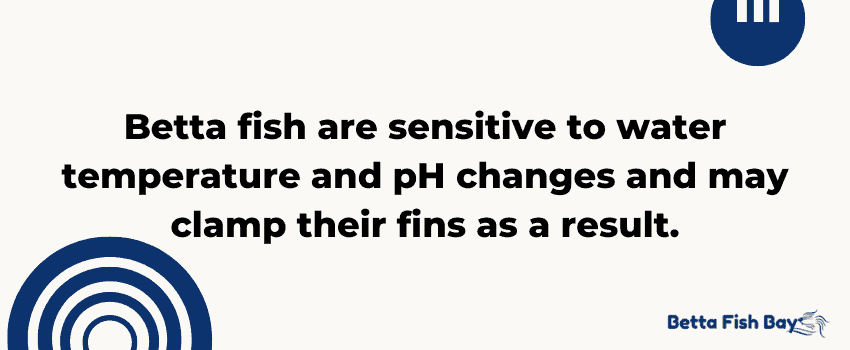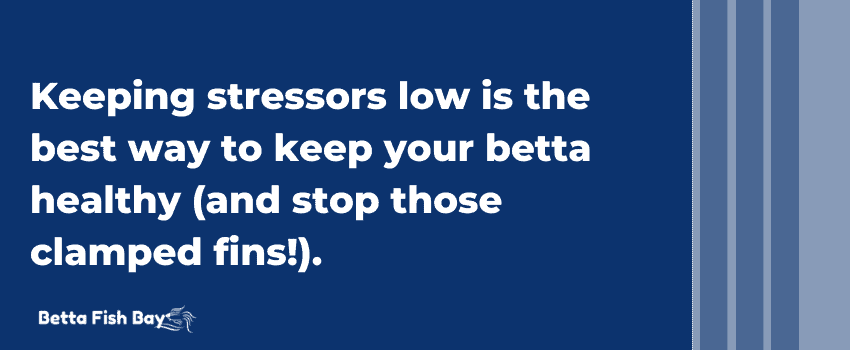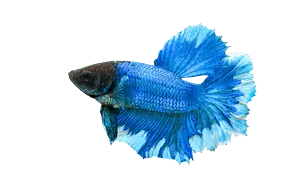Have your bettas’ fins been looking a bit off?
It might be clamped fins! This issue is common and treatable, but what is it?
Clamped fins are a common condition in betta fish. It’s characterized by a betta’s fins being pressed close against its body and appearing “stuck together.” This condition indicates an issue with health, environment, or stress levels. Sometimes, it may be due to old age or genetic abnormalities.

Table of Contents
Betta Problems Causing Clamped Fins
Clamped fins are a symptom of another issue.
You need to tell the difference between the potential causes to figure out why it’s happening. We’ll go over the most common ones here.
Fin Rot
Fin rot is a health issue common in bettas.
It can present as a disease or as a symptom of a disease. This makes it critical to diagnose the issue and begin treatment immediately.
Common manifestations of fin rot in bettas include:
- Redness or discoloration of the fins
- Bleeding fins
- Torn or injured fins
- Fraying along the fins’ edges
- Lack of appetite
- Lethargy
Torn Fins
Torn fins are a less serious issue, usually resulting from an injury or a bacterial or fungal infection. In some cases, torn fins are a symptom of fin rot and need prompt treatment.
Columnaris
Columnaris produce symptoms similar to fin rot, though there are distinctive differences.
For example, columnar tends to be more severe, causing symptoms such as the following:
- Swollen, pale lips
- White or gray patches
- Skin loss
- Excess mucus production
Common Symptoms With Clamped Fins In Betta
Clamped fins in betta may cause or be accompanied by other symptoms:
- Lethargy
- Lack of appetite
- Changes in behavior, such as flashing or aggression
Since clamped fins are often a symptom of a larger problem, it’s essential to monitor your bettas closely once you notice it.
The presence of other symptoms will help you properly identify what’s wrong with your betta.
Root Causes Of Clamped Fins In Betta

There are a few common reasons for clamped fins in betta fish. These include, but are not limited to, the following:
Stress
Betta fish experiencing stress are likelier to fall ill or become infected by a parasite. It’s critical to ensure your bettas’ aquarium and tank mates are not causing them stress.
Your fish may be feeling stressed if any of these things are true:
- The tank is too small, causing overcrowding
- The water quality is poor
- The temperature is not ideal
- The bettas’ tank mates are aggressive
Illness
If your betta is ill, the disease may be causing clamped fins. Illness not only affects the betta’s body, but it also causes stress.
Even if the disease doesn’t cause clamped fins, its stress can.
Unfortunately, freshwater fish such as bettas are prone to various diseases and parasitic infections:
- Anchor worms
- Betta lice
- Dropsy
- Fin rot
- Gill flukes
- Ich
Regularly monitor your fish’s behavior and appearance for signs of illness.
If you think something is up, have a certified vet diagnose and treat your bettas.
Poor Water Quality
The water quality in your bettas’ tank can also put them at risk of developing clamped fins.
Ensure the aquarium water is free of toxins or heavy metals, such as lead and mercury.
These substances are harmful to fish, causing them stress and potential illness.
Ammonia spikes are another common issue in freshwater aquariums. Levels of this substance increase as feces increase in the aquarium.
Avoid this issue by performing frequent water changes and not overcrowding your tank.
Poor water quality also puts your bettas at risk of bacterial infections.
Changes in Temperature or pH

Bettas are beautiful tropical fish requiring very specific water parameters to thrive.
If these parameters are not met or change suddenly, it can make your fish stressed or ill.
To keep your bettas healthy, ensure the water parameters are always within the following ranges:
Ideal Water Parameters for a Betta Fish Tank Include the following:
- Temperature: 78-80° degrees Fahrenheit (25.5-27° C)
- pH: 6.5-7.5
- Ammonia and Nitrite: 0 ppm
- Nitrate: < 40 ppm
- gH: 3-4 dGH (50-66.7 ppm)
- kH: 3-5 dKH (53.6-89.4 ppm)
- Minimum Tank Size: 5 Gallons
By performing frequent water changes, help your bettas avoid shock from rapidly changing water conditions.
For new fish, gradually mix their water with water from the main aquarium. This will help acclimate them to the water conditions they’ll be living in.
Preventing Clamped Fins In Betta
Proper attention and betta fish care prevents clamped fins and other diseases.
Maintaining Good Water Quality
Bad water conditions can cause clamped fins in betta fish. Bettas require good water quality to thrive.
Ensure your bettas’ water is at the correct temperature and pH level.
If the water is too cool or warm, it may cause the fish to become stressed or ill. Likewise, if the water is too acidic or not acidic enough, your fish will suffer.
Good water quality also means the water is free of harmful substances. Examples of harmful substances include the following:
- Ammonia
- Nitrates
- Lead
- Mercury
- Arsenic
- Copper
Consider purchasing a water quality testing kit like this one to ensure the quality of your bettas’ water.
Providing a Suitable Tank
Prevent your bettas from undue stress by providing them with a suitable tank. There are a few parameters to consider during tank setup.
Tank Size
The tank should be at least five gallons for a single betta fish.
Bettas require ample space to swim and roam. Depriving them of this results in elevated stress levels and a greater risk of disease or infection.
Further, too-small tanks may result in overcrowding. When there are too many fish in the tank, it may cause the following issues:
- Elevated stress levels
- More aggressive behavior
- Fecal matter buildup
- Ammonia buildup
For every new fish you get, upgrade the tank size to accommodate them. Alternatively, consider owning multiple tanks to avoid overcrowding or aggression.
Tank Shape
Bettas tend to thrive best in rectangular aquariums.
These aquariums mimic the natural shallow-water environments in which bettas typically live. Additionally, they provide the best possible gas exchange for bettas.
Tank Layout
Bettas require plenty of space to roam and places to hide. Adding decorations such as plants can help bettas feel more at home.
Here are a few tips on betta fish tank layout:
- Install the tank filter. It should install on one side of the tank. The filter is crucial in keeping the water quality within optimal parameters.
- Cover the bottom of the tank with gravel or substrate. Ensure you leave a layer of about two inches. The gravel or substrate should be a neutral color, which is calming to bettas.
- Add plants and decorations. These will help your betta feel more secure and at home. For plants, bury their roots deep in the substrate you laid down in the previous step. Then, place decorations throughout the tank as you see fit. Ensure the decorations are well-anchored. Also, avoid using too many, as this can cause overcrowding.
- Fill the tank with high-quality water. Ensure the water meets optimal temperature, pH, and harmful substances parameters.
These steps will help ensure your betta remains calm, healthy, and happy.
Minimizing Stress

Bettas stress easily, and many betta fish diseases result from stress.
Keep their tank within optimal parameters and monitor their behavior to help lower their stress levels.
There are several ways to help reduce stress among your bettas:
- Keeping water temperature between 78-80° degrees Fahrenheit (25.5-27° C)
- Keeping pH levels between 6.5 and 7.5
- Providing plenty of space and hiding places
- Performing frequent water changes
- Avoiding overcrowding
- Avoiding overfeeding your bettas
- Acclimating new fish to the tank
The key to stress-free, healthy fish is an environment which fosters well-being and happiness.
Offering a Nutritious Diet
Feed your bettas a nutritious diet to help prevent issues such as clamped fins.
This will give your bettas stronger immune systems, allowing them to fight off infection and disease.
Betta fish need lots of protein and fiber in their diet. Additionally, they should be getting a good mix of different nutrients, vitamins, and minerals.
There are a few types of betta fish food to consider:
- Pellets. This is the most common type of betta fish food. Pellets expand once they hit the water, making them a filling meal for bettas. However, they may cause digestive issues if your fish eats too many. Feeding your betta 2-4 pellets 1-2 times daily is recommended.
- Flakes. Another common betta food type, flakes, tend to be messier than pellets. Further, bettas often refuse to eat flakes at all. It’s best to try them out with your bettas and see whether they will eat them.
- Freeze-dried. Many foods bettas eat in their natural environment are available in freeze-dried form. This is the most convenient way to feed them “real” food without the risk of aquarium parasites or disease.
- Live or frozen. Finally, your bettas can enjoy live or frozen food. These types of food have high nutritional value, but they should not make up the majority of your bettas’ diet. They may be more expensive than other options, and they may transmit parasites or diseases to your fish.
Experts agree: feeding your bettas various food types is the best way to keep them healthy and thriving.
Treating Clamped Fins For Betta
If your bettas already have clamped fins, there are treatment options available.
Treatment generally involves improving the water quality, providing a stress-free environment, and administering medication.
Improving Water Quality
Clamped fins are often the result of poor water conditions. It’s critical to ensure the aquarium water is always within optimal parameters.
We recommend using a comprehensive water quality test kit to test the tank water. Follow the directions on the packaging to test the water for various metrics:
- pH levels
- Heavy metals
- Ammonia levels
- Other toxins
Additionally, purchase a water temperature test to always keep tabs on any water quality issues.
Providing a Stress-free Environment
Stressed bettas are more likely to develop clamped fins or other health issues.
Keep them unstressed by providing an environment suited to their unique needs.
While your fish is healing from clamped fins, a stress-free environment is more important than ever. Follow these steps to help your bettas recover more quickly:
- Perform frequent water changes.
- Test the water regularly for temperature, pH, and toxins.
- Avoid overfeeding your bettas.
- Ensure there is plenty of space to roam.
- Provide hiding places throughout the tank.
Administering Medication
Depending on the cause of your bettas’ clamped fins, different medication options are available.
For parasitic infections, consider using one of the following medications:
| Dosage (Active Ingredient) | Usage | |
|---|---|---|
| Trichlorfon | 0.25–0.50 mg/L | Apply 1x per week for 4 weeks |
| Diflubenzuron | 0.03 mg/L | After the first treatment, apply another treatment about two weeks later |
| Lufenuron | 0.1mg/L–0.13 mg/L | Apply 1x per week for 5 weeks |
Alternatively, an aquarium salt bath is another effective remedy for several causes of clamped fins.
Make sure to watch your betta both during and after the salt bath.
If it shows signs of distress during the salt bath, immediately remove it and place it back in the original tank.
If the betta is still in distress after removing it, have it treated by a certified vet.
Let Those Fins Spread Wide
Clamped fins in betta aren’t anything to panic about, and it’s a symptom of a deeper issue.
Fortunately, clamped fins are often an easy fix and prevent with proper betta care, especially with removing stress and keeping the tank setup safe.
Learn more about why betta need plants in their tank.


